Feature Articles - Women and WWI - Feminist and Non-Feminist Women: Between Collaboration and Pacifist Resistance
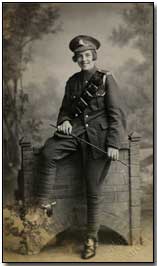 There is much controversy as to whether the granting of the vote to women was
the outcome of WWI or part of a current towards the progressive democratisation
of Western societies. After all, in countries such as New Zealand (1893),
Australia (1901), Finland (1906) or Norway (1913) women got the vote before the
war began, whereas others such as Denmark (1915), Iceland (1915), Holland (1917)
or Sweden (1919) enfranchised women during the war without being involved in it.
There is much controversy as to whether the granting of the vote to women was
the outcome of WWI or part of a current towards the progressive democratisation
of Western societies. After all, in countries such as New Zealand (1893),
Australia (1901), Finland (1906) or Norway (1913) women got the vote before the
war began, whereas others such as Denmark (1915), Iceland (1915), Holland (1917)
or Sweden (1919) enfranchised women during the war without being involved in it.
Among the combatants, women were in some cases given the vote towards the end of the war or after Armistice (Russia, 1917; Germany, 1918; US, 1919) but in France and Italy they had to wait until 1945 to see this right acknowledged despite the fact that, at least in France, feminist suffragists were very active. Besides, the enfranchising of women over 30 in Britain did not really benefit the young women of any class who'd born the brunt of most war-related activities.
It is very likely, though, that British male politicians simply wanted to avoid a situation in which women would get not only the vote but also a majority.
Feminist women were to be found in all classes but always as a minority; working-class feminists, besides, would often combine feminism and trade-unionism much to the dismay of their upper-class sisters. Feminism and socialism needn't go together and this may well explain why feminist agitator Emmeline Pankhurst eventually became a member of the Tory party.
Paradoxically, most conservative anti-feminist women - of any class - supported the war though feminists like Pankhurst were also pro-war; in any case, it can be said with little doubt that practically all pacifist women were also feminists. To sum up: not all women supported feminism, and among those who did, lines were divided between pro-war and anti-war positions.
It is true, however, that the women in key positions as administrators in Government organisations, front-line pseudo-NGOs and home front political and trade unions were feminists, as were most women writers. This is why we get the impression that the war and feminism were intimately related when it might well be that the pro-war, anti-suffrage conservative position was majority among women between 1914 and 1918, even among those the war placed in jobs formerly the exclusive domain of men.
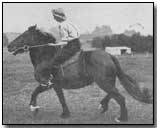 At the time war broke out the New Woman born around the 1880s was competing with
the lady for pre-eminence among the middle and upper classes while working-class
women were divided among those who wished to be primarily housewives and those
who wanted to be workers protected by the progressively more powerful trade
unions.
At the time war broke out the New Woman born around the 1880s was competing with
the lady for pre-eminence among the middle and upper classes while working-class
women were divided among those who wished to be primarily housewives and those
who wanted to be workers protected by the progressively more powerful trade
unions.
The ladies and the conservative women workers became downright supporters or just appalled sufferers caught between their belief in traditional patriarchal values and the evidence of what war was doing to the bodies and minds of the men - and to their own. The ladies volunteered to do aid and relief work, from knitting socks for the boys to working as VADs in home front hospitals, while more enterprising females formed bodies such as the infamous Women's Patrols.
These were formed at the instigation of the Headmistresses' Association in 1914 to monitor the loose morals of young women in contact with soldiers billeted locally. There were numerous complaints against their zealous patrolling of public parks and cinemas though they were welcomed by the War Office to patrol near military camps and were thus not so far from the more serious Women's Police Volunteers - later Women's Police Service - formed by Margaret Dawson.
Part of the contradictions of feminism can be seen in the fact that Dawson's second in command, Mary Allen, was a member of Pankhurst's Women's Political and Social Union (WSPU) but drifted after the war towards Nazism. Although Allen became a full member of a local police force the WPV women were never allowed to join the regular Police as they were thought to be overeducated in comparison to policemen, something that might have hurt male pride among the force.
This is just one of many instances in which women's good will and unpaid effort was exploited by the Government and the same can be said in general of war propaganda, both that created by women spontaneously and that in which women were used without consulting or plainly against their will.
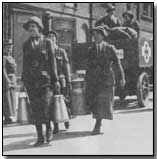 As is well-known,
posters accompanied by forceful slogans - "Women of Britain Say Go!" - often used
women to entice men to go to the front, though avoiding at the same time calling
women to these tasks. Mrs. Humphrey Ward's propaganda work has already been
mentioned but entertainers such as Vesta Tilley and other writers such as Jessie
Pope, May Wedderburn Cannan or Emma Orczy were involved in supporting
conservative pro-war views either individually or sponsored officially by the
Government or the military.
As is well-known,
posters accompanied by forceful slogans - "Women of Britain Say Go!" - often used
women to entice men to go to the front, though avoiding at the same time calling
women to these tasks. Mrs. Humphrey Ward's propaganda work has already been
mentioned but entertainers such as Vesta Tilley and other writers such as Jessie
Pope, May Wedderburn Cannan or Emma Orczy were involved in supporting
conservative pro-war views either individually or sponsored officially by the
Government or the military.
Orczy was an active member of the Organisation of the White Feather, started by Admiral Charles Fitzgerald in 1914, devoted to the sorry task of shaming men into fighting for Britain by branding them publicly as cowards via the handing of a conspicuous white feather.
The letter that the Little Mother sent to the editor of the Morning Post (1916) and that Robert Graves reproduces and comments on in his memoirs stands out as an example of the extreme jingoism often attributed to home front women. This letter, released as a pamphlet, sold 75,000 copies in just own week. "We women," Little Mother writes, "pass on the human ammunition of 'only sons' to fill up the gaps, so that when the 'common soldier' looks back before going 'over the top' he may see the women of the British race at his heels. Reliable, dependent, uncomplaining." It is tempting to believe no woman wrote this letter and if she did, it was only by taking dictation from a man.
The two main organisations working for the enfranchisement of women at the outbreak of WWI represented very different approaches to feminism. The National Union of Women's Suffrage Societies (NUWSS) founded in 1897 and led by Millicent Fawcett had about 100,000 members in 1914, while its rival organisation, Emmeline Pankhurst's Women's Social and Political Union, founded in 1903 by a NUWSS dissident group, had about 2,000.
Both the NWUSS and the WSPU agreed to suspend their political agitation when the war began but had subsequently dramatically different approaches to war and the war effort. The NWUSS helped, for instance, by sponsoring women's hospital units, but refused to collaborate in any kind of recruiting strategy. In contrast, Pankhurst and the Government signed a deal by which the WSPU offered to collaborate in this in exchange for the release of the women imprisoned on account of the excesses their political activism led them to.
It is hardly an exaggeration to say that the suffragettes' tactics bordered on terrorism while Pankhurst herself certainly had an authoritarian, fascist streak in her. In contrast, the NWUSS women turned in many cases progressively towards pacifism.
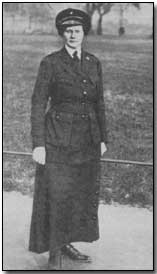 The Government sponsored the WSPU, having found in their demagogic style of
protest a useful ally and so they were active setting up demonstrations and
publishing pro-war propaganda in their periodical, also harassing those who were
not up to their jingoistic standards.
The Government sponsored the WSPU, having found in their demagogic style of
protest a useful ally and so they were active setting up demonstrations and
publishing pro-war propaganda in their periodical, also harassing those who were
not up to their jingoistic standards.
Emmeline and her supportive daughter Christabel formed eventually the Women's Party in 1917 with lines no less patriotic. Their feminism could still be seen in their demands for equal pay and legal rights though their initial socialist beliefs had all but disappeared, to the point that they assumed eventually an anti-trade union stance.
In contrast, Sylvia Pankhurst became estranged from her mother and sister for never abandoning those socialists beliefs and combining them with pacifism. While Emmeline and Christabel supported, like many other middle-class feminists, a franchise limited to their own class, Sylvia was in favour of universal suffrage; Emmeline and Christabel were in favour of conscription, whereas Sylvia organised a monumental demonstration against it.
The Military Service Act of 1916, which enforced the conscription of men between the ages of 18 to 41, marked no doubt the beginning of the second stage of feminist pacifist protest against the war though the first began together with the war, crystallising in the International Women's Congress for Peace and Freedom at The Hague (1915).
This was organised by the Dutch pacifist feminist Aletta Jacobs with the help of German feminists Anita Augspurg and Lida Gustava Heymann. The 1,136 delegates from both 12 combatant and neutral countries (Austria, Belgium, Britain, Canada, Denmark, Germany, Holland, Hungary, Italy, Norway, Sweden and the United States) attest to the women's widespread international resistance to war; many more would have attended if they hadn't been prevented from travelling, as happened when Winston Churchill ordered the North Sea closed to the British delegates.
The Women's International League for Peace and Freedom, still standing today, was founded then following the principles espoused by the Women's Peace Party created also in 1915 by American feminist leaders Jane Addams and Carrie Chapman Catt. The International Women's Peace Party was also formed as a result of this singular pacifist conference.
British women like Chrystal Macmillan - later secretary of the International Women Suffrage Alliance - were closely involved in the running of the Hague conference. She and the other British Hague delegates, Emmeline Pethick-Lawrence and Catherine Marshall, formed the British section of the League together with pacifists Charlotte Despard - a follower of Gandi's policy of 'passive resistance' who was also sister to General French, commander of the B.E.F. - Helena Swanwick, Sylvia Pankhurst and veteran feminist Olive Schreiner. Their membership of the League often overlapped with that of the Women's Peace Party.
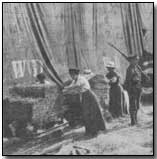 These are some of the women that reacted with all their political and emotional
might against conscription joining the ranks of the Union of Democratic Control
and the Non-Conscription Fellowship among other organisations. Margaret Cole,
another pacifist, was firmly converted to the anti-conscription cause when her
brother Raymond Postgate was sent to prison for refusing to be drafted.
These are some of the women that reacted with all their political and emotional
might against conscription joining the ranks of the Union of Democratic Control
and the Non-Conscription Fellowship among other organisations. Margaret Cole,
another pacifist, was firmly converted to the anti-conscription cause when her
brother Raymond Postgate was sent to prison for refusing to be drafted.
The Peace Movement brought together women from all classes and all kinds of interests for the first time after the outbreak of the war, from Cole to Selina Cooper, Hannah Mitchell and future cabinet minister Margaret Bonfield, a noted trade unionist. Others like Ottoline Morrell contributed by turning their own homes into centres where influential figures like Bertrand Russell could develop their pacifist contacts. The tightness of this circle is shown by the fact that Russell worked in close contact in the Non-Conscription League with Catherine Marshall, though not always in agreement over their priorities.
As Jo Vellacot reminds us in her article Anti-War Suffragists (History, 62 (1977), pp. 411-25, pacifist feminists soon saw the need to defend universal adult suffrage, a belief out of which the National Council for Adult Suffrage was born in 1916.
Vellacot concludes that in the end, the war had "very slight" effects on women's suffrage, and that women "neither earned it by their war work nor jeopardised it by their wartime opposition." Vellacot herself notes that the war did affect, however, feminism itself as it split the movement neatly into a right-wing faction and a left-wing faction, not so much out of class identification but out of diverse political concerns.
Before the war, all feminist women had the common objective of gaining the vote for all women. After WWI and taking, of course, into account the impression made by the Russian socialist revolution of 1917, feminism was no longer politically uniform - if it ever was. Once the vote was granted, and indeed after 1928 when universal suffrage was obtained, feminist women were and still are split in two by their twin allegiance to the gender they belong to and the political ideas they defend, loyalties that can often be totally contradictory.
Although Britain is the main focus of this article, it's also worth considering what happened in the USA, Germany, France and other countries involved in WWI regarding women's suffrage.
 In the USA, President
Woodrow Wilson signed the
US
19th Amendment, ratified by Congress in 1920, which enfranchised American women
as a way of thanking them for their readiness to help in the war effort. Paradoxically, the first woman elected to the House of Representatives (1917)
and member of Congress (up to 1919) was the Republican feminist pacifist
Jeannette Rankin, who voted both against participation in WWI and WWII.
In the USA, President
Woodrow Wilson signed the
US
19th Amendment, ratified by Congress in 1920, which enfranchised American women
as a way of thanking them for their readiness to help in the war effort. Paradoxically, the first woman elected to the House of Representatives (1917)
and member of Congress (up to 1919) was the Republican feminist pacifist
Jeannette Rankin, who voted both against participation in WWI and WWII.
Canadian women were thanked in the same way in 1917 for the same reason; strangely enough, married Canadian men couldn't enlist without their spouses' written permission, which made Canadian married women the object of a singular pro-war campaign.
Richard Evans explains in Comrades and Sisters: Feminism, Socialism and Pacifism in Europe, 1870-1945 (Sussex: Wheatsheaf Books, 1987, pp. 66-90) that "By far the most impressive - though by no means the only - example of a working-class female suffrage movement is to be found in the case of Imperial Germany, in the form of the women's section of the Social Democratic Party of Germany."
German women got the vote in 1918 as a result of the revolution that left the socialists at the front of the post-Armistice Weimar Republic. "In Germany", he notes, "when the SPD leader August Bebel introduced a motion for female suffrage into the Reichstag for the first time ever (in 1895) he justified it simply 'in the name of the legal equality of the sexes'." When the revolution did happen in 1918, SPD leaders, though, "saw the granting of the vote to women largely as a means of pacifying the masses and stealing the thunder of the far left."
Amy Hackett stresses in Feminism and Liberalism in Wilhelmine Germany, 1890-1918 (1971) that, in any case, the liberal feminist movement born in Wilhelmine Germany, whether bourgeois or working-class, Protestant or Catholic, "wished to maintain, even to cultivate and exalt, traditional 'feminine' qualities - especially women's maternal, nurturing 'instincts' - as unique and valuable additions to culture."
The French case is the most puzzling. Neither the French Revolution nor the Third Republic of 1870, which coincided with the birth of most feminist movements in the West, granted women the same rights as men, paying thus lip service to the slogan 'liberty, fraternity, equality'. Yet, the French Union for Women's Suffrage was confident that the vote would be won after the war. Thus, French feminists were mostly pro-war and refused to take part in the Hague conference, with very few individual exceptions.
As James F. McMillan writes "by identifying with the state, feminists could hope that the state would identify with women and recognise their rights in the public sphere" (The Coming of Women's Suffrage 1914-1945: Feminists and the First World War.
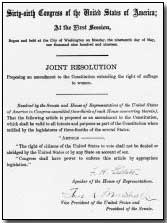 Far from happening, as Steven C. Hause comments (More Minerva than Mars: The
French Women's Rights Campaign and the First World War,
the war stopped the feminist movement on its tracks, actually setting it back. French feminists were a middle-class, urban, non-religious minority to a
majority of anti-feminist, Catholic women. Yet, both the French Union for
Women's Suffrage (UFSF) and the National Council of French Women (CNFF) had no
doubts that the vote would be won.
Far from happening, as Steven C. Hause comments (More Minerva than Mars: The
French Women's Rights Campaign and the First World War,
the war stopped the feminist movement on its tracks, actually setting it back. French feminists were a middle-class, urban, non-religious minority to a
majority of anti-feminist, Catholic women. Yet, both the French Union for
Women's Suffrage (UFSF) and the National Council of French Women (CNFF) had no
doubts that the vote would be won.
This didn't happen, as, essentially, although the Chamber of Deputies passed the bill enfranchising women in 1919 the French Senate decided that the country had more urgent matters to solve and started procrastinating until the women's suffrage matter was put last in its agenda. There were also fears that French women would be an easy prey as voters to the interests of the church, an idea that went back decades into the 19th century; the splits within the French feminist movements due to the impact of the Russian Revolution also acted against female suffrage. As has been noted, both French and Italian women were granted the vote only after WWII by Governments that wanted to make a clean break with pre-1945 undemocratic regimes.
Next - Women in the Workforce: Temporary Men
A 'corkscrew' was a metal post for supporting a wire entanglement, with a twisted base enabling it to be screwed into the ground, removing the need for a hammer, the use of which could attract enemy fire.
- Did you know?
